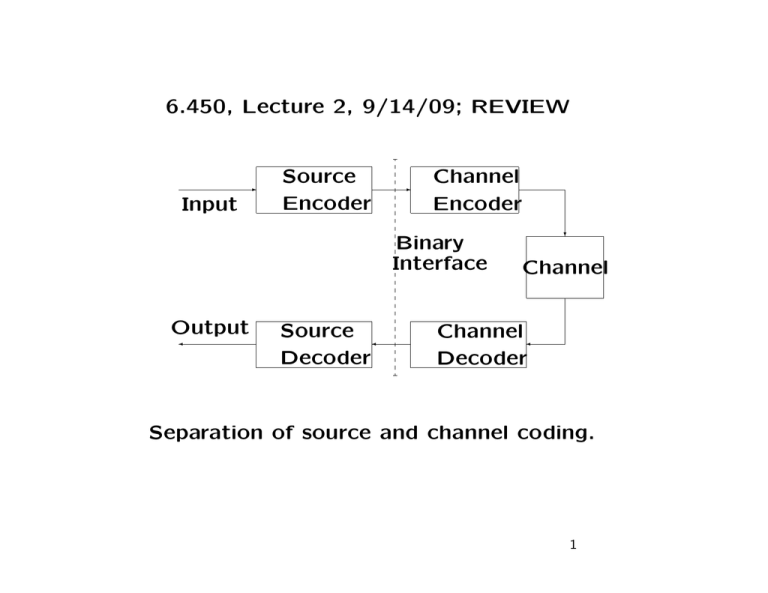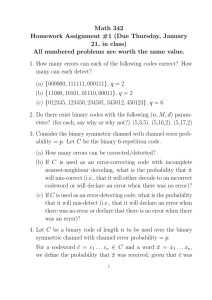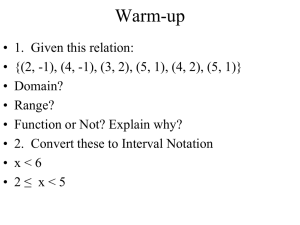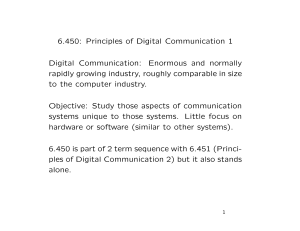Document 13512716
advertisement

6.450, Lecture 2, 9/14/09; REVIEW
✲
Input
Source
Encoder
✲
Channel
Encoder
Binary
Interface
Output
✛
Source ✛
Decoder
❄
Channel
Channel ✛
Decoder
Separation of source and channel coding.
1
REASONS FOR BINARY INTERFACE
• Standardization (Simplifies implementation)
• Layering (Simplifies conceptualization)
• Loses nothing in performance (Shannon says)
2
input ✲
sampler
waveform
✲
quantizer
✲
discrete
coder
❄
analog
sequence
output
✛
waveform
analog ✛
filter
table
lookup
symbol
sequence
✛
discrete
decoder
reliable
binary
Channel
✛
Layering of source coding
3
input ✲
sampler
waveform
✲
quantizer
✲
discrete
coder
❄
analog
sequence
output
✛
waveform
analog ✛
filter
table
lookup
symbol
sequence
✛
discrete
decoder
reliable
binary
Channel
✛
⇑
A waveform source is usually sampled or
expanded into a series, producing a sequence
of real or complex numbers.
4
input ✲
sampler
waveform
✲
quantizer
✲
discrete
coder
❄
analog
sequence
output
✛
waveform
analog ✛
filter
table
lookup
symbol
sequence
✛
discrete
decoder
reliable
binary
Channel
✛
⇑
The analog sequence is encoded by
quantization into sequence of symbols.
5
input ✲
sampler
waveform
✲
quantizer
✲
discrete
coder
❄
analog
sequence
output
✛
waveform
analog ✛
filter
table
lookup
symbol
sequence
✛
discrete
decoder
reliable
binary
Channel
✛
⇑
Both analog and discrete sources then require
binary encoding of sequence of symbols.
6
DISCRETE SOURCE CODING
OBJECTIVE: Map sequence of symbols into
binary sequence with unique decodability.
SIMPLEST APPROACH: Map each source sym­
bol into an L-tuple of binary digits.
Choose L as smallest integer satisfying 2L ≥ M ,
i.e.,
log2 M ≤ L < log2 M + 1;
L = dlog2 M e
7
Example (for alphabet {red, blue, green,
yellow, purple, magenta}):
red →
000
blue →
001
green →
010
yellow →
011
purple →
100
magenta → 101
This can be easily decoded.
Example:
the ASCII code maps let­
ters, numbers, etc. into bytes.
These are called fixed length codes.
8
FIXED-TO-FIXED LENGTH SOURCE
CODES
Segment source symbols into n-tuples.
Map each n-tuple into binary L-tuple where
log2 M n ≤ L < log2 M n + 1;
L = dn log2 M e
Let L = L
n be number of bits per source symbol
log2 M ≤ L < log2 M +
1
n
9
VARIABLE LENGTH SOURCE CODES
Motivation: Probable symbols should have shorter
codewords than improbable to reduce bpss.
A variable-length source code C encodes each
symbol x in source alphabet X to a binary
codeword C(x) of length l(x).
For example, for X = {a, b, c}
C(a) = 0
C(b) = 10
C(c) = 11
10
Decoder must parse the received sequence.
Requires unique decodability: For every string
of source letters {x1, x2, . . . , xn}, the encoded
output {C(x1)C(x2), . . . , C(xn)} must be distinct,
i.e., must differ from {C(x01)C(x02), . . . , C(x0m)} for
any other source string {x01, . . . , x0m}.
If C(x1) · · · C(xn) = C(x01) · · · C(x0m), decoder must
fail on one of these inputs.
We will show that prefix-free codes are uniquely
decodable.
11
Unique Decodability: For every string of source
letters {x1, x2, . . . , xn}, the encoded output
{C(x1)C(x2), . . . , C(xn)} must be distinct, i.e., must
differ from {C(x01)C(x02), . . . , C(x0m)} for any other
source string {x01, . . . , x0m}.
If C(x1) · · · C(xn) = C(x01) · · · C(x0m), decoder must
fail on one of these inputs.
Example: Consider a → 0, b → 01, c → 10
Then ac → 010 and ba → 010,
Not uniquely decodable.
12
Unique Decodability: For every string of source
letters {x1, x2, . . . , xn}, the encoded output
{C(x1)C(x2) · · · C(xn)} must be distinct, i.e., must
differ from {C(x01)C(x02) · · · C(x0m)} for any other
source string {x01, . . . , x0m}.
If C(x1) · · · C(xn) = C(x01) · · · C(x0m), decoder must
fail on one of these inputs.
Example: Consider a → 0, b → 01, c → 11
Then accc → 0111111=016; bccc → 01111111=017.
This can be shown to be uniquely decodable.
13
PREFIX-FREE CODES
A code is prefix-free if no codeword is a prefix
of any other codeword. A prefix of a string
y1, . . . , yk is y1, . . . , yi for any i ≤ k.
A prefix-free code can be represented by a bi­
nary tree which grows from left to right; leaves
represent codewords.
✟
✟✟
1
✟
✟
b
✟✟
✟❍
✟
✟
❍❍
✟
✟✟
✟
✟
❍
❍❍ ✟✟
✟✟
❍✟
✟
❍❍
❍❍
❍❍
❍❍
❍❍
❍❍
❍
❍
1
0
0
a
1
0
c
a→0
b → 11
c → 101
Every codeword is at a leaf, but not all leaves
are codewords. Empty leaves can be short­
ened. A full code tree has no empty leaves.
14
✏
✏✏
✏
✏✏
✏✏PPP
✏
✏
PP
P
✏✏
P
✟
P
✟
PP
✟
PP
✏
✟✟
✟
✏✏
✏
❍
✓ ❍❍
✏✏
✏✏PPP
✓
❍❍
✏
PP
✏✏
✓
❍✏
P
PP
PP
✓
PP
✓
✓
✓
✓
❅
✏
❅
✏✏
✏
✏
❅
PP
✟✏
❅
✟
PP
✟
PP
❅
✟
✟
❅✟
PP
PP
PP
1
b
ba
c
ca
bb
bc
cb
cc
ab
ac
0
a
aa
Prefix-free codes are uniquely decodable:
Construct a tree for a concatenation of codewords.
To decode, start at the left, and parse when­
ever a leaf in the tree is reached.
15
THE KRAFT INEQUALITY
The Kraft inequality is a test on the existence
of prefix-free codes with a given set of codeword lengths {l(x), x ∈ X }.
Theorem (Kraft): Every prefix-free code for
an alphabet X with codeword lengths {l(x), x ∈
X } satisfies
X
x∈X
2−l(x) ≤ 1
(1)
Conversely, if (1), then a prefix-free code with
lengths {l(x)} exists.
Moreover, a prefix-free code is full iff (1) is
satisfied with equality.
16
We prove this by associating codewords with
base 2 expansions i.e., ‘decimals’ in base 2.
Represent binary codeword y1, y2, . . . , ym as
.y1y2 · · · ym = y1/2 + y2/4 + · · · + ym2−m
1.0
✻
Interval [1/2, 1)
1 −→ .1
❄
✻
01 −→ .01
❄
✻
00 −→ .00
❄
Interval [1/4, 1/2)
Interval [0, 1/4)
17
Represent binary codeword y1, y2, . . . , ym as
.y1y2 · · · ym = y1/2 + y2/4 + · · · + ym2−m
1.0
✻
Interval [1/2, 1)
1 −→ .1
❄
✻
01 −→ .01
❄
✻
00 −→ .00
❄
Interval [1/4, 1/2)
Interval [0, 1/4)
C(aj ) is a prefix of C(ai) if and only if the expan­
sion of C(aj ) contains the expansion of C(ai) in
its “approximation interval.”
18
1.0
✻
Interval [1/2, 1)
1 −→ .1
❄
✻
01 −→ .01
❄
✻
00 −→ .00
❄
Interval [1/4, 1/2)
Interval [0, 1/4)
C(aj ) is a prefix of C(ai) if and only if the expan­
sion of C(aj ) contains the expansion of C(ai) in
its “approximation interval.”
Thus a code is a prefix code iff the base 2
approximation intervals are disjoint.
19
1.0
✻
Interval [1/2, 1)
1 −→ .1
❄
✻
01 −→ .01
❄
✻
00 −→ .00
❄
Interval [1/4, 1/2)
Interval [0, 1/4)
A code is a prefix code iff the base 2 approxi­
mation intervals are disjoint.
But the sum of disjoint approximation intervals
is at most 1.
20
1.0
✻
Interval [1/2, 1)
1 −→ .1
❄
✻
01 −→ .01
❄
✻
00 −→ .00
❄
Interval [1/4, 1/2)
Interval [0, 1/4)
The sum of disjoint approximation intervals is
at most 1.
Code is full iff approximation intervals fill up
[0, 1)
21
DISCRETE MEMORYLESS SOURCES
• The source output is an unending sequence,
X1, X2, X3, . . . , of randomly selected letters
from a finite set X , called the source al­
phabet.
• Each source output X1, X2, . . . is selected
from X using a common probability mea­
sure.
• Each source output Xk is statistically inde­
pendent of the other source outputs X1, . . . ,
Xk−1, Xk+1, . . . .
22
Probability Structure for Discrete Sources
English text: e, i, and o are far more probable
than q, x, and z.
Successive letters are dependent; (th and qu).
Some letter strings are words, others are not.
Long term grammatical constraints.
The discrete memoryless source is a toy model
that can be easily generalized after understand­
ing it.
23
PREFIX-FREE CODES FOR DMS
Let l(x) be the length of the codeword for let­
ter x ∈ X .
Then L(X) is a random variable (rv) where
L(X) = l(x) for X = x.
Thus L(X) = l(x) with probability pX (x).
E(L) = L =
X
x
pX (x)l(x)
Thus L is the number of encoder output bits
per source symbol.
24
OBJECTIVE: choose integers {l(x)} subject to
Kraft to minimize L.
Let X = {1, 2, . . . , M } with pmf p1, . . . , pM .
Denote the unknown lengths by l1, . . . , lM .
Lmin =
min
P
l1,... ,lM :
M
X
2−li ≤1
i=1
pili
Forget about the lengths being integer for now.
P
Minimize Lagrangian: i(pili + ∏2−li ).
@
P
−l
i(pili + ∏2 i )
@li
= pi − ∏(ln 2)2−li = 0
Choose ∏ so that the optimizing {li} satisfy
P −l
i 2 i = 1. Then any other choice of {li} sat­
isfying constraint will have a larger L̄.
25
@
P
−l
i(pili + ∏2 i )
= pi − ∏(ln 2)2−li = 0
@li
If we choose ∏ = 1/ ln 2, then
pi = 2−li
li = − log pi
Lmin(non−int.) =
X
i
−pi log pi = H(X)
H(X) is called the entropy of the rv X. We
will see that it is the minimum number of bi­
nary digits per symbol needed to represent the
source.
For now, it is a lower bound for prefix-free
codes.
26
Theorem: Entropy bounds
Let Lmin be the minimum expected codeword
length over all prefix-free codes for X. Then
H(X) ≤ Lmin < H(X) + 1
Lmin = H(X) iff each pi is integer power of 2.
Proof of H(X) ≤ L for prefix-free codes:
Let l1, . . . , lM be codeword lengths.
X
1 X
H(X) − L =
p log − i pili
i i
pi
X
2−li
=
p log
,
i i
pi
27
°
°
°
°
°
°
°
°
°
°
°
°
°
°
°
u−1
1
ln u
u
The inequality ln u ≤ u−1 or log u ≤ (log e)(u−1).
This inequality is strict except at u = 1.
H(X) − L =
=
X
p log
i i
X h
2−li
pi
i
≤
X
p
i i
"
2−li
pi
#
− 1 log e
−li − p log e ≤ 0
2
i
i
Equality occurs iff pi = 2−li for each i.
28
Theorem: Entropy bound for prefix-free codes:
H(X) ≤ Lmin < H(X) + 1
Lmin = H(X) iff each pi is integer power of 2.
Proof that Lmin < H(X) + 1:
Choose li = d− log(pi)e. Then
li < − log(pi) + 1
li ≥ log(pi)
so
so
Lmin ≤ L < H(X) + 1
X
i
2−li ≤
X
pi = 1
i
29
MIT OpenCourseWare
http://ocw.mit.edu
6.450 Principles of Digital Communication I
Fall 2009 For information about citing these materials or our Terms of Use, visit: http://ocw.mit.edu/terms.






